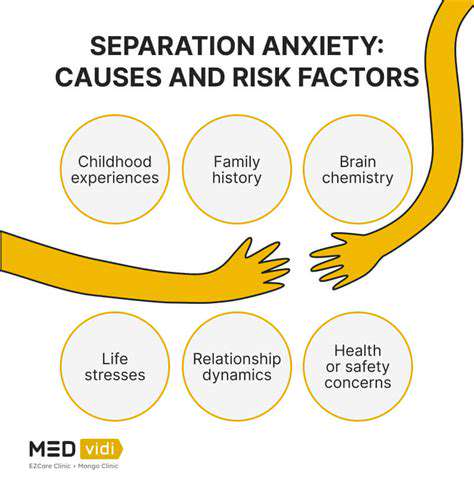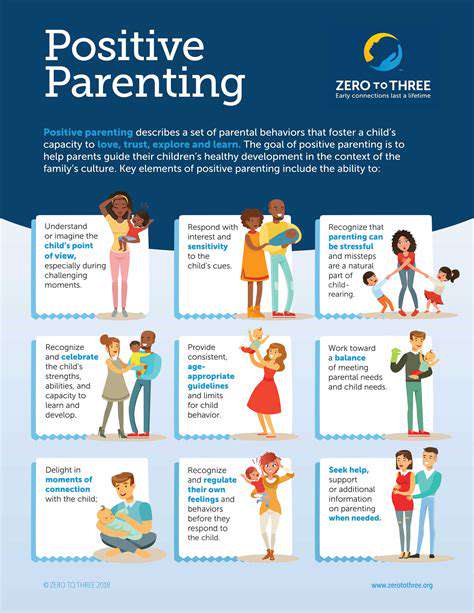Effective Strategies for Managing Separation Anxiety in Children
What Causes Separation Anxiety?
Genetic and Environmental Factors
Separation anxiety can be influenced by a child's genetic make-up, which may predispose them to anxiety-related disorders. If parents or siblings have a history of anxiety, it can increase the likelihood that a child will experience similar issues.
Moreover, environmental factors, such as family dynamics and stressors, play a significant role. Children are highly observant and may pick up on parental stress, which can exacerbate their feelings of anxiety when separated from caregivers.
Understanding these factors can help parents recognize that separation anxiety is often not a reflection of parenting skills but a complex interplay of genetics and environment.
Developmental Milestones and Separation Anxiety
Separation anxiety is a normal part of childhood development, particularly in toddlers and preschoolers. As children become more self-aware and begin to understand their surroundings, they might feel a heightened sense of awareness regarding the absence of their caregivers.
This anxiety usually peaks between the ages of 9 and 18 months, coinciding with significant developmental milestones. As children learn to walk and explore their environment, they may become more anxious about being away from their primary attachment figure.
Parents should recognize that this phase is temporary and can provide a safe space for their children to navigate their feelings of separation while gradually building their confidence and independence.
Tips for Reducing Separation Anxiety
Consistency is key when addressing separation anxiety. Establishing a clear and predictable routine can help children feel more secure about their day-to-day activities. When children know what to expect, it can reduce their anxiety associated with separation.
Gradual exposure is another effective strategy. Start with short separations that progressively increase in length. This can help the child habituate to the absence of the caregiver and understand that they will always return.
Additionally, parents can reinforce positive behaviors associated with separation by offering praise or rewards when children demonstrate independence, thus encouraging them to manage their anxiety more effectively.
When to Seek Professional Help
While some level of separation anxiety is normal, it can become problematic if it interferes with a child’s daily activities, such as attending school or participating in social events. Parents should monitor their child's behavior and determine whether their anxiety is excessive or persistent.
If a child's anxiety leads to extreme distress, physical symptoms (such as stomachaches or headaches), or avoidance behaviors, it may be time to consult a mental health professional. They can provide guidance and therapeutic techniques that are tailored to the child's specific needs.
Early intervention can be very effective in helping children develop coping strategies, and it can also alleviate the worry and stress experienced by parents dealing with a child's severe separation anxiety.
Common Symptoms of Separation Anxiety

Recognizing Behavioral Indicators
One of the most critical steps in managing separation anxiety is recognizing its behavioral indicators. Children may exhibit signs such as clinginess, tantrums, or refusal to participate in activities that separate them from their primary caregivers. These behaviors can manifest during drop-offs at school or daycare, making it essential for parents to be aware of these patterns.
Additionally, some children may resort to seeking physical closeness or might follow their parents around the house. Understanding these behavioral cues can help caregivers address the anxiety more effectively and provide necessary support.
Effective Coping Techniques
Employing coping techniques is vital for helping children navigate their separation anxiety. Techniques such as gradual exposure, where a child slowly acclimates to separation, can be extremely beneficial. This could involve short separations followed by positive reinforcements to build their confidence.
Moreover, teaching children relaxation techniques like deep breathing or visualization can empower them to manage their feelings. When children learn to manage their anxiety, they become more resilient to future separations.
Collaboration with Educators and Caregivers
Collaborating with teachers and caregivers is essential in creating a supportive environment for children dealing with separation anxiety. Communication can help establish a consistent approach to addressing the child's needs. By working together, parents and educators can implement strategies that provide stability and reassurance.
Furthermore, sharing observations and strategies can foster better understanding and enhance the child's comfort in different settings. Building a team around the child can make the coping process smoother and more effective.
Helpful Strategies for Parents

Understanding the Causes of Separation Anxiety
Separation anxiety in children often arises from a variety of factors, including developmental stages, environmental changes, and individual temperament. Identifying the underlying causes is crucial for effective management. Children may experience anxiety when faced with new situations, such as starting school or moving to a new home.
Additionally, some children may inherit anxious tendencies from their parents, making it essential for parents to be aware of their own responses to stress. The home environment also plays a significant role; a stable and supportive atmosphere can help mitigate anxiety.
Understanding your child's triggers will allow you to equip them with coping strategies tailored to their specific needs. Furthermore, the way parents respond to their child’s anxiety can reinforce or alleviate the behavior, making awareness crucial.
Lastly, it’s important to recognize that separation anxiety is a normal developmental phase for many children, and with the right support, it can be a manageable challenge.
Practical Techniques for Easing Anxiety
Establishing consistent routines can significantly help children manage their separation anxiety. Predictability in daily activities provides children with a sense of security and helps them prepare for transitions. Creating a goodbye ritual, such as a special handshake or hug, can also provide comfort.
Another effective technique is gradual desensitization, where parents slowly expose their children to short separations before escalating to longer ones. This method helps children acclimate to being apart from their caregivers in a safe and controlled manner.
Encouraging open conversation about feelings can foster emotional intelligence in children. Parents should reassure their children that it’s okay to feel anxious and that these feelings will pass. Regular check-ins can reinforce their support and validate their emotions.
Finally, positive reinforcement when a child manages their anxiety can boost their confidence. Celebrating small victories helps shift the focus from fear to accomplishment, enabling children to develop resilience over time.
When to Seek Professional Help
Recognizing the Signs of Separation Anxiety
Separation anxiety is a common developmental phase in children, typically emerging between the ages of 6 months and 3 years. One of the primary signs is excessive distress when a child is separated from their caregiver, which may manifest in crying, tantrums, or clinginess. Additionally, children may express fear of being alone or worry about something bad happening to their parents.
Children experiencing separation anxiety may also exhibit physical symptoms, such as stomachaches or headaches, particularly before separations. Some may avoid specific situations or places where they have to part from their caregivers, such as school or playdates.
It's important for parents to differentiate between mild separation anxiety and more severe cases that disrupt daily routines. When a child's anxiety leads to persistent refusal to attend school or engage in social situations, it may require more immediate attention.
Observing how long the anxiety lasts and the behaviors associated with it will help in understanding whether the child is experiencing typical development or if there are deeper issues at play.
Creating a Secure Environment
One effective strategy for managing separation anxiety is to establish a secure and consistent environment for the child. A predictable routine helps children feel safe and know what to expect, which can significantly reduce anxiety during separations.
Incorporating comforting elements into the child’s daily life, such as favorite toys or blankets, can provide additional security. Allowing the child to engage in a favorite activity before a separation can also create positive associations with being apart from their caregiver.
Furthermore, transitioning to separations gradually can help ease the stress involved. Parents might start by leaving the child with a trusted caregiver for short periods, gradually increasing the time spent apart as the child becomes more comfortable.
Encouraging independence through small tasks, like dressing themselves or playing independently, can also contribute to building the child's confidence and resilience in facing separations.
Implementing Gradual Separation Techniques
Gradual separation techniques can provide a gentle way to help children manage their anxiety. Parents might begin by practicing short separations when the child is calm in a familiar environment, such as leaving the room for a few minutes and returning. This can help the child learn that separations are temporary.
Another approach is to establish goodbye rituals. This could be as simple as a special handshake or a fun phrase that signifies the transition. These rituals can help the child feel in control and ease the emotional burden of separation.
To further support the child during the process, parents can prepare them by discussing separations ahead of time, explaining where they will be and when they will return. Preparing the child mentally can make the experience feel less daunting.
Providing positive reinforcement after successful separations can reinforce the child’s bravery. Compliments or small rewards for handling separations well can help build their confidence over time.
Encouraging Emotional Expression
Creating opportunities for children to express their emotions openly is vital in managing separation anxiety. Parents should encourage their children to talk about their feelings, validating their fears and anxieties instead of dismissing them.
Using storytelling or role-playing can be an effective method to help children articulate their feelings. Books that address separation anxiety tailored to the child's age can also serve as a tool for discussing fears and coping mechanisms.
Artistic expression through drawing or painting can allow children to release their feelings creatively. Encouraging children to depict their emotions visually can offer insights into their internal struggles.
Modeling healthy emotional expressions oneself can influence children positively. When caregivers demonstrate how to navigate feelings of fear or uncertainty calmly, children learn to adopt similar strategies in their lives.
When to Seek Professional Help
While separation anxiety is a normal part of childhood development, there are signs that indicate when professional help may be necessary. If the child’s anxiety is severe or persistent—causing distress or impairment in functioning—parents should consider seeking guidance from a mental health professional.
Indicators that it’s time to seek help include the child exhibiting extreme withdrawal from social situations, consistent nightmares regarding separation, or if anxiety leads to physical symptoms impacting overall well-being.
Professionals can provide tailored strategies and interventions to address the child's specific challenges. They may recommend cognitive-behavioral therapy or other therapeutic methods that have proven effective in treating anxiety in children.
Early intervention can significantly impact a child's ability to cope with anxiety, helping them develop the necessary skills to navigate separations in the future. Parents should not hesitate to reach out for support if they feel overwhelmed by their child’s anxiety.
- Essential fall care tips for your dog’s health
- Navigating the Evolution of Nutritional Needs Throughout Life
- Identifying Signs of Anxiety and Stress in Daily Life
- Decoding Canine Communication: Insights into Dog Behavior
- Calming Collars for Dogs: A Natural Solution for Anxiety
- Tips for calming a stressed or anxious dog
- Effective Ways to Manage Separation Anxiety in Dogs
- How to reduce separation anxiety in dogs